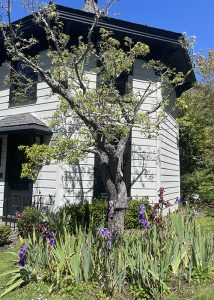
In our mild Bay Area climate, mid-winter can often seem like spring. There are still some important planting tasks at this time of year that you should consider, which will benefit your garden year-round, including planting cover crops.
Cover crops are plants whose primary use is improving the soil, rather than as a food source. Certain plants concentrate nutrients and nitrogen in the soil as they grow, leaving it better than they found it. Gardeners use cover crops mainly in “production” beds, such as vegetable gardens or cut flowers, and we’ve had good success using them in our raised beds here in the Edible Garden.

We’re always looking for gardening methods that reduce our use of animal-based additives, and cover crops help us to do just that. If you have chickens or livestock, cover crops can be feed for them as well, and it’s certainly more pleasing to see a bed of thriving fava plants than a bare fallow patch of earth. Erosion risks are lower as well.
While you can plant cover crops at any time of year, we like to use this period to refresh our soil before our summer vegetables go into the ground. We choose varieties that grow well in cooler weather, and seed them shortly after harvesting the last of our autumn crops.
Favas and other legumes are nitrogen fixers, so it’s important to pull them before they produce fruit—otherwise the nitrogen will be expended by the plant, rather than concentrated in the soil. If you’re sorry to miss out on a spring harvest of beans, do as we do and plant extra, so you’ll be able to leave some growing for your dinner table.
Grains and grasses, such as oats, rye, or buckwheat are useful for adding green matter, which composts in the soil, improving its texture and attracting beneficial microbes and worms. You’ll want to till these under before they set seeds, otherwise you’ll get weeds. Tender clover and vetch also fix nitrogen, and can be mowed down or tilled under as green matter; again, till them early before seeds mature.
If your soil is heavy or compacted, often the case in backyard gardens that were converted from lawns, you may want to try growing a crop with long tap roots that will do some of the work of breaking up the soil for you. Certain types of radishes, mustards, and brassicas can be good choices; be sure to pull them up when you’re ready to plant your next crop to get the greatest aerating effect and avoid re-sprouting.
This season we’ve planted a seed mixture consisting of oats to provide green matter and in fact work as a trellis to support vining crops, with fava beans, field peas and vetch as both nitrogen fixers and green matter in the beds where we grow the heaviest feeders (tomatoes, peppers, squash, and cucumbers). Come take a look, and if you have any questions, submit them to gardentips@maringarden.org!




